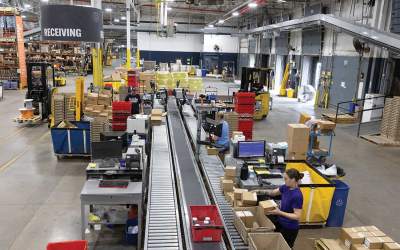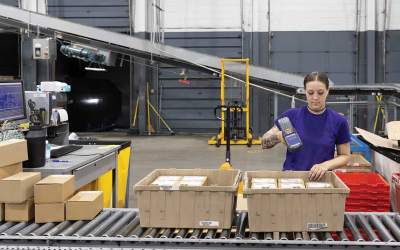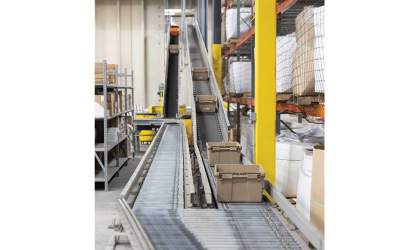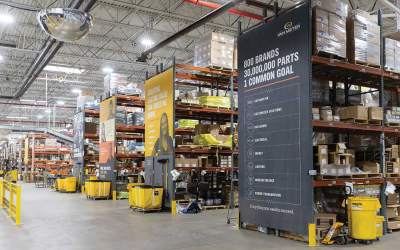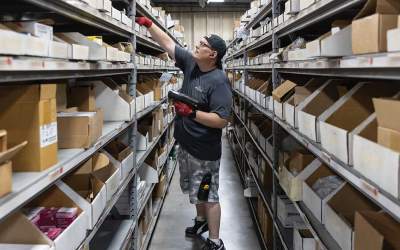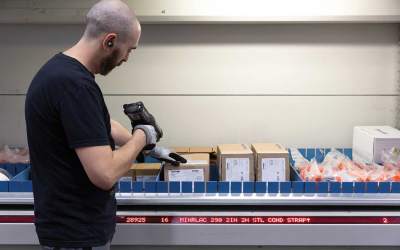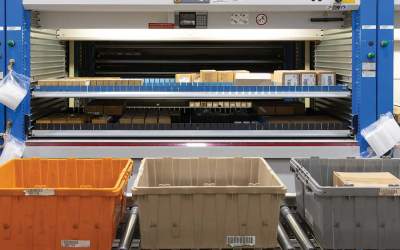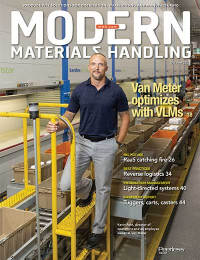Van Meter optimizes with vertical lift modules (VLMs)
Vertical lift modules save space, reduce travel and speed goods in distributor’s Iowa distribution center.
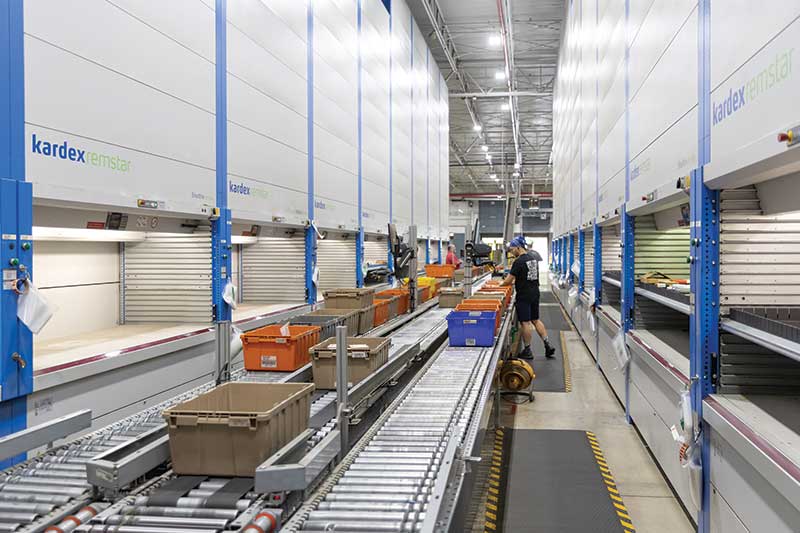
Saving space, reducing travel time and accelerating the flow of goods through the facility are three of the benefits Van Meter, an employee-owned distributor of electrical and automation supplies, has realized since implementing vertical lift modules, or VLMs (Kardex Remstar).
And while the units were first installed in 2016 in its 300,000- square-foot distribution center in Cedar Rapids, Iowa, Van Meter has been optimizing the system and its processes ever since to get more out of its original investment.
“Prior to the VLMs, we had a pick and pass system with conveyor in a shelving area plus picking from a high bay storage area,” notes Kevin Foht, director of operations and an employee owner at the company. “We were running out of space to serve our growing business, and the conveyor system could no longer handle the speeds or order quantities that we require today. We had to do something so that we could grow the business and enter new markets.”
VLMs allowed the company to gain storage space without adding on to the facility. “At that time, we needed more space but there wasn’t property available to expand,” Foht recalls. “The VLMs allowed us to utilize the whole ceiling height of the building.”
A secondary benefit was a safer work environment because product could now be delivered to order selector workstations at an ergonomic height. The VLM zone features 18 vertical lift modules distributed across four work zones—two on either side of the conveyor system with each integrated with pick-to-light technology.
Orders are batch picked from three picking zones and then consolidated in the packing area: Order fulfillment starts in what they call the grey shelving area, an area designated for case storage.
Items are picked to totes that are then conveyed to a VLM zone. Once all items are picked from the VLMs, they are conveyed to the high bay storage area. There, the totes are placed on carts to complete an order. Oversized items and non-conveyables are also stored in the high bay area.
While the space has been expanded, the initial implementation saved at least two aisles of high bay shelving. In addition to saving space, Foht estimates the facility has doubled picking throughput, reduced labor requirements by 21%, and increased accuracy to 99.95%.
“When you have space or efficiency issues, you limit your ability to serve your customers,” Foht says. “VLMs position us to support our customers and be a value-add for them. For instance, during Covid, we made strategic buys to make sure that we had the inventory needed to support our large industrial customers. The VLMs gave us the space to store that additional product.”
Focus on space
Van Meter may not be a household name to most readers, but from its headquarters in Iowa, the 95-year-old, 100% employee-owned company is a leading distributor of electrical parts and components, with a concentration in the industrial manufacturing and construction industry. Its competitive advantage is customer service, providing next-day delivery across the Midwest on orders received by 4:30 p.m. The company fills more than one million lines per year from Cedar Rapids.
In addition to the 300,000-square-foot Iowa facility, Van Meter operates another 300,000-square-foot facility in Kansas City and a 150,000-square-foot facility in Minnesota, which it gained after a strategic acquisition. In addition to shipping to customers, the distribution centers support a network of more than 20 branches that serve the communities where they are located, primarily in the Midwest.
“It’s a hub-and-spoke model. We replenish each of the branches out of the distribution centers based on min/max inventory levels. And about 90% of the orders are picked and packed in the regional distribution centers and shipped to the branches that then crossdock them onto a truck.” - Foht
The customer base includes the agricultural industry, commercial contractors, manufacturers, utility providers and institutional customers, such as commercial buildings and educational institutions. The processes support products as small as electrical components and as large as solar panels and 20-foot-long lengths of pipe.
“It’s a challenge to handle all of those different size variations,” Foht notes. And, while they may fill larger orders, it’s rare that they ship a full pallet quantity of any one SKU, which means the facility is often picking and aggregating orders with both conveyable and non-conveyable items.
Prior to first installing VLMs in 2016, the Cedar Rapids facility was running out of space. Expanding wasn’t an option, so Van Meter looked for space-saving technologies.
Enter the VLMs. “At the time, some of the technologies for dense storage now on the market weren’t available,” says Foht. “VLMs gave us the ability to utilize the whole cube of the facility.” That initial installation consisted of 18 VLMs spread across zones, with people assigned to pick and put. With a focus on space, “we just filled up the machine with SKUs to create more room on the floor,” Foht says. “Over time, we became much more efficient based on how we slotted inventory.”
Shift the focus to growth
In 2017, a year after the implementation of the VLMs, Van Meter changed its focus from space to growth. “We set a goal to double our business by 2025,” Foht recalls. “With that in mind, we asked what our infrastructure needed to look like to support that growth.”
A year later, the company launched a program called “Built to Last,” which called for adding significant square footage to the Cedar Rapids facility, and ultimately to the network. In addition to adding 44,000 square feet to the original building, they purchased an additional 70,000 square feet. The Cedar Rapids expansion was followed by the opening of a 300,000-square-foot facility in Kansas City and then a 150,000-square-feet acquisition in Minneapolis.
In 2019 with the expansion complete, Foht and his team began work on optimizing operations inside the four walls of the Cedar Rapids facility. They called it “Transforming for the Future.”
“Our focus was on accuracy, speed and labor savings over space,” Foht recalls. “We put in a new conveyor system, new shipping docks, re-slotted the warehouse and optimized the VLM area.” To align the team, Van Meter had t-shirts made for warehouse employees with the ‘Built to Last’ and ‘Transforming for the Future’ taglines. They were a reminder of what they were all working toward with the changes.
A new conveyor system was one of the first changes. It was designed to handle the order volumes and speed required to meet customer service requirements, especially for next-day delivery for orders received late in the day.
“Our basic model is that we’ll deliver any order received by 4:30 p.m. the next day, anywhere in the state of Iowa,” Foht says. Another important change was tying the conveyor line into receiving. “Before the new conveyor, we put pallets away in the high bay area or put cartons on carts and pulled the carts to the grey shelving area,” says Foht. “Now, we can prepare for put-away in receiving and induct totes onto the conveyor.”
During busy picking times, they can turn off the receiving line and stage up to 100 totes; then release them once they have worked through the backlog of orders. Inventory is picked and replenished throughout the day.
A second important change was re-slotting the facility, including the VLMs. In the grey shelving storage and high bay areas, the fastest moving items were relocated closer to the conveyor. “Rather than put-away by vendor, we slotted according to velocity,” Foht says. “We looked at what items we were picking the most, the receiving quantity and which items were suitable for totes.
As part of the re-slotting, about 2,400 SKUs were moved from the grey zone shelving area into the VLMs, which increased the pick speed by 30% for those items. In total, the VLMs are reserved for about 10% of the total number of SKUs, but those SKUs represent more than a third of the items ordered on a daily basis. There are two sizes of trays in the machines: Smaller trays are used for parts less than 15 inches high and lighter weight; larger trays can hold up to 790 pounds per tray.
Through the combination of the new conveyor system, optimizing the layout and slotting, Van Meter was able to position the same number of VLMs in four zones instead of six, with four people assigned to those zones. In the new layout, the conveyor runs down the middle of the VLM area, with nine machines on one side and nine on the other, with two people working on each side.
“We became so efficient in the VLMs that we didn’t need as many people in that zone,” Foht says. About 75% of the picks come out of the grey shelving and VLM zones, with only 25% coming from the high bay area.
The changes allowed Van Meter to double its picking throughput, reduce labor requirements by 21% and increase accuracy to 99.95%. As an example, associates are picking at a rate of 20 lines per hour in the high bay zone; 50 lines per hour in the grey shelving area; and an average of 65 lines per hour with peaks as high as 100 lines per hour from the VLMs.
For now, VLMs and higher levels of automation are only used in Cedar Rapids, but Foht is looking at ways to improve the Minneapolis and Kansas City facilities. “When you have space or efficiency issues, it limits your ability to serve your customer,” Foht says. “The VLMs and the new conveyor system are allowing us to meet the goals we set back in 2018 to take our business to the next level.”

Article Topics
Epicor News & Resources
Van Meter optimizes with vertical lift modules (VLMs) Inside Top Notch Distribution: Bringing robotics to hardware distribution ERP expands alongside WMS Epicor to accelerate Cloud ERP adoption with Microsoft Azure New software suite with optional modules boosts picker effectiveness 10 Questions You Need to Ask Before Choosing a Cloud-based ERP 10 Questions You Need to Ask Before Choosing a Cloud-based ERP More EpicorLatest in Materials Handling
Geek+ and System Teknik deploy PopPick solution for pharmacy group Med24.dk Beckhoff USA opens new office in Austin, Texas Manhattan Associates selects TeamViewer as partner for warehouse vision picking ASME Foundation wins grant for technical workforce development The (Not So) Secret Weapons: How Key Cabinets and Asset Management Lockers Are Changing Supply Chain Operations MODEX C-Suite Interview with Harold Vanasse: The perfect blend of automation and sustainability Consultant and industry leader John M. Hill passes on at age 86 More Materials HandlingAbout the Author
Subscribe to Materials Handling Magazine

Find out what the world's most innovative companies are doing to improve productivity in their plants and distribution centers.
Start your FREE subscription today.
April 2024 Modern Materials Handling

Latest Resources


